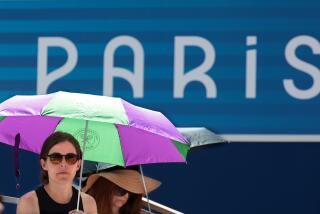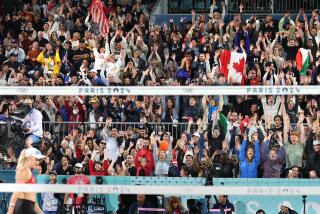Stringtime in Paris : French Open Tennis Tourney Is a Hot Corporate Ticket
- Share via
PARIS — During the last week in May and the first in June, the most exclusive business address in France is not the banking strip along the Avenue des Champs-Elysees, the corporate office towers in La Defense or even the Paris stock exchange, La Bourse.
For 15 magic days, as spring gently recedes and fashionable Parisians strut out in their new summer wardrobes, the focus of the business world in the French capital shifts a few miles away from the main commercial centers to the bright red clay courts of Roland Garros Stadium, site of the annual French Open Championship tennis tournament, at the southern tip of the sprawling Bois de Boulogne.
“Over the past 10 years it has evolved into a springtime rite,” observed Vincent Nouzille, a journalist for the French business magazine L’Expansion. “There are thousands of VIPs and would-be VIPs vying for space. Companies get into fights over the best boxes at center court. Between set points, they talk business and drink a glass of champagne or good red wine. Offices in the center of town empty of people.”
A common joke is that even those who do not have tickets, particularly in the critical last four days of the tournament, vacate their offices so that people will not know they are not at Roland Garros. Senior politicians and corporate managers are in such cheek-by-jowl prominence at the stadium that an outsider might reasonably ask who is running France. Andre Agassi? Stefan Edberg?
Tickets to the presidential tribune, a section at the north end of center court, are so limited that last year tournament marketing manager Gilles Bertoni said he tried and failed to obtain one for comedian Jerry Lewis, even though the American entertainer is an idol in France.
“We searched all over,” said Bertoni, one of a team of young managers who have steered the French Open from a $5-million business in 1982 to a $50-million business this year. “Thank goodness, we were finally able to find him a place in another box, although not in the presidential tribune.”
Although nitty-gritty business details are seldom discussed at Roland Garros, the tournament site--with its soothing evergreen-and-white color scheme and the top of the Eiffel Tower peering over the horizon like a line judge--is considered to provide the ultimate atmosphere for the big deal that needs a final sweeping gesture of goodwill.
It was widely reported that, between sets at the 1987 French Open, the French electronics company Thomson and General Electric concluded their agreement in principal for Thomson to purchase the GE-owned RCA home electronics division.
But anyone expecting to do business in France during this period--it’s May 25-June 7 this year--better have an invitation from one of the major sponsors or a center court ticket in hand months before they arrive. In a society that thrives on exclusivity and elitism, Roland Garros passes are the rarest of all privileges.
The demand for the 100,000 tickets held by sponsors (out of a total 300,000-plus tickets sold) is so great that IBM, the American computer giant and a sponsor of the championship had to enforce a strict rule that no seats be made available to even its most senior executives unless they can demonstrate a compelling business-related need. To make the point even more forcefully, IBM requires its managers to pay for the seats and VIP meals from their own division budgets.
“We have sensitized our people,” said IBM-France Director of Promotions Bruno Favier, standing in the elegant, glass-walled, 65-seat IBM restaurant and lounge constructed under the sloping stadium walls of Court No. 1, “that what we do here is really all business.”
Favier said IBM-France spends 3% of its annual marketing budget on the tournament.
The rise of the French Open as a business-related venue is a relatively recent phenomenon. America, with its trademark Super Bowl hype and sports-industrial complex, has long mixed business with big sporting events. Corporate hospitality suites, front-row tickets for good customers, post-game parties and back-slapping client contact are all American inventions. But the French are comers.
Once they got the idea, the French management team at Roland Garros employed the country’s great national talent for mixing business and pleasure to great advantage. In 1980, Philippe Chatrier, president of the French Tennis Federation, which controls the tournament, introduced the sponsor village on the fringe of the complex of 15 courts.
Sponsors pay between $8,000 and $25,000 a day--the cost rises as the tournament rogresses--for a small open-air “tent” pavilion in the village. Renting a tent also gives the sponsors priority to as many as 100 center court tickets, which costs them another $5,000.
Each day of the tournament, an elegant four-course lunch is served in the tents--menus created by Parisian chefs Michel Rostang and Guy Savoy and served by the famous French caterer Potel et Chabot. A recent menu featured a tart of wild herbs, medallions of steamed veal, fresh ravioli, a platter of assorted French cheeses and a light chocolate cake with a lime base. The wines included Champagne, a 1990 Chablis and a 1979 Margaux from Bordeaux.
The sponsors contend that few people are likely to forget a lunch like that. It also explains why many invited to Roland Garros never see a single point played.
Potel et Chabot Director General Yves Le Naour said that before the tournament is over his company will have served 18,000 bottles of wine, 10,000 bottles of Champagne and literally tons of goose liver, caviar and smoked salmon.
The level of cuisine mounts as the tournament draws to a climax.
“As the competition proceeds,” said Le Naour, “the quality evolves just until the final. The guest lists begin with the directors of public relations and end with the presidents of the companies.”
This elimination and filtering process, not possible in a one-day event such as the Super Bowl, is widely considered the key to the business success of Roland Garros. Just as the players are sorting themselves out on the courts, a fierce process of unnatural selection is taking place in the boxes of center court.
The general public is allotted seats through advance sales and membership in local clubs that belong to the tennis federation. But the 5,000 or so center court seats held by corporate sponsors belong to the French and foreign power elite.
“During the last four days of the tournament,” said a spokesman for Banque Nationale de Paris, the state-owned bank that is the tournament’s principal sponsoring partner, “our president and CEO are present and meet with our most important clients--owners of big businesses, financial directors, people at the highest levels of the business and political world.”
French Open at a Glance
French Open Championships (May 25-June 7)
Attendance:
1982: 238,305
1991: 333,786
(Capacity: 28,000 daily)
Estimated Revenue:
(Tickets, concessions, product and tournament sponsorships, advertising, etc.)
1982: About $5 million; (25 million French francs)
1992: About $50 million; (250 million French francs)
Ticket Price:
$40-$50 daily
Corporate box, four places on center court: $30,000 for two years
Main sponsors:
Banque Nationale de Paris, IBM-France, Peugeot, Perrier, Thomson
More to Read
Sign up for Essential California
The most important California stories and recommendations in your inbox every morning.
You may occasionally receive promotional content from the Los Angeles Times.













